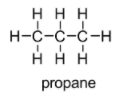
Define:
(a) Saturated hydrocarbon
(b) Unsaturated hydrocarbon
(c) Catenation
Answer
506.4k+ views
Hint: All the organic compounds possessing carbon as well as hydrogen atoms are known as hydrocarbons. These are naturally-occurring compounds and they generally form the basis of natural gas, crude oil, coal, and other energy sources.
Complete step by step answer:
Hydrocarbons are mainly classified as saturated hydrocarbons and unsaturated hydrocarbons.
(a) Saturated hydrocarbon: Saturated hydrocarbons are the simplest form of hydrocarbons consisting of only single bonded carbon atoms. They are known as saturated owing to the capacity of each carbon atom to form bonds with as many hydrogen atoms as possible. We can say that carbon atoms are saturated with the hydrogen atoms. Example: alkanes like methane, ethane, propane, etc.

(b) Unsaturated hydrocarbon: Unsaturated hydrocarbons belong to the class of hydrocarbons which possess either double or triple covalent bonds between the adjacent carbon atoms. The term "unsaturated" indicates that more hydrogen atoms can be appended into the hydrocarbon in order to make it saturated. Generally, an unsaturated hydrocarbon includes straight chains (alkenes and alkynes) and also branched chains or aromatic compounds. Examples: propene, propyne, cis-2-butene, cyclopentene etc.

(c) Catenation: Catenation refers to the process in which an element binds to itself via covalent bonds which leads to the formation of either chain or ring molecules. Carbon is the most common example of an element which exhibits catenation. Carbon can lead to the formation of long hydrocarbon chains as well as rings like benzene.

Note: If hydrocarbons enter the lungs, it usually causes pneumonia and even death. Some hydrocarbons can also cause coma, irregular heart rhythms, seizures, or damage to the liver or kidneys.
Complete step by step answer:
Hydrocarbons are mainly classified as saturated hydrocarbons and unsaturated hydrocarbons.
(a) Saturated hydrocarbon: Saturated hydrocarbons are the simplest form of hydrocarbons consisting of only single bonded carbon atoms. They are known as saturated owing to the capacity of each carbon atom to form bonds with as many hydrogen atoms as possible. We can say that carbon atoms are saturated with the hydrogen atoms. Example: alkanes like methane, ethane, propane, etc.

(b) Unsaturated hydrocarbon: Unsaturated hydrocarbons belong to the class of hydrocarbons which possess either double or triple covalent bonds between the adjacent carbon atoms. The term "unsaturated" indicates that more hydrogen atoms can be appended into the hydrocarbon in order to make it saturated. Generally, an unsaturated hydrocarbon includes straight chains (alkenes and alkynes) and also branched chains or aromatic compounds. Examples: propene, propyne, cis-2-butene, cyclopentene etc.

(c) Catenation: Catenation refers to the process in which an element binds to itself via covalent bonds which leads to the formation of either chain or ring molecules. Carbon is the most common example of an element which exhibits catenation. Carbon can lead to the formation of long hydrocarbon chains as well as rings like benzene.

Note: If hydrocarbons enter the lungs, it usually causes pneumonia and even death. Some hydrocarbons can also cause coma, irregular heart rhythms, seizures, or damage to the liver or kidneys.
Latest Vedantu courses for you
Grade 11 Science PCM | CBSE | SCHOOL | English
CBSE (2025-26)
School Full course for CBSE students
₹41,848 per year
Recently Updated Pages
Master Class 11 Business Studies: Engaging Questions & Answers for Success

Master Class 11 Economics: Engaging Questions & Answers for Success

Master Class 11 Accountancy: Engaging Questions & Answers for Success

Master Class 11 Computer Science: Engaging Questions & Answers for Success

Master Class 11 English: Engaging Questions & Answers for Success

Master Class 11 Maths: Engaging Questions & Answers for Success

Trending doubts
The flightless birds Rhea Kiwi and Emu respectively class 11 biology CBSE

1 litre is equivalent to A 1000mL B 100cm3 C 10mL D class 11 physics CBSE

A car travels 100 km at a speed of 60 kmh and returns class 11 physics CBSE

Name the Largest and the Smallest Cell in the Human Body ?

Explain zero factorial class 11 maths CBSE

In tea plantations and hedge making gardeners trim class 11 biology CBSE




